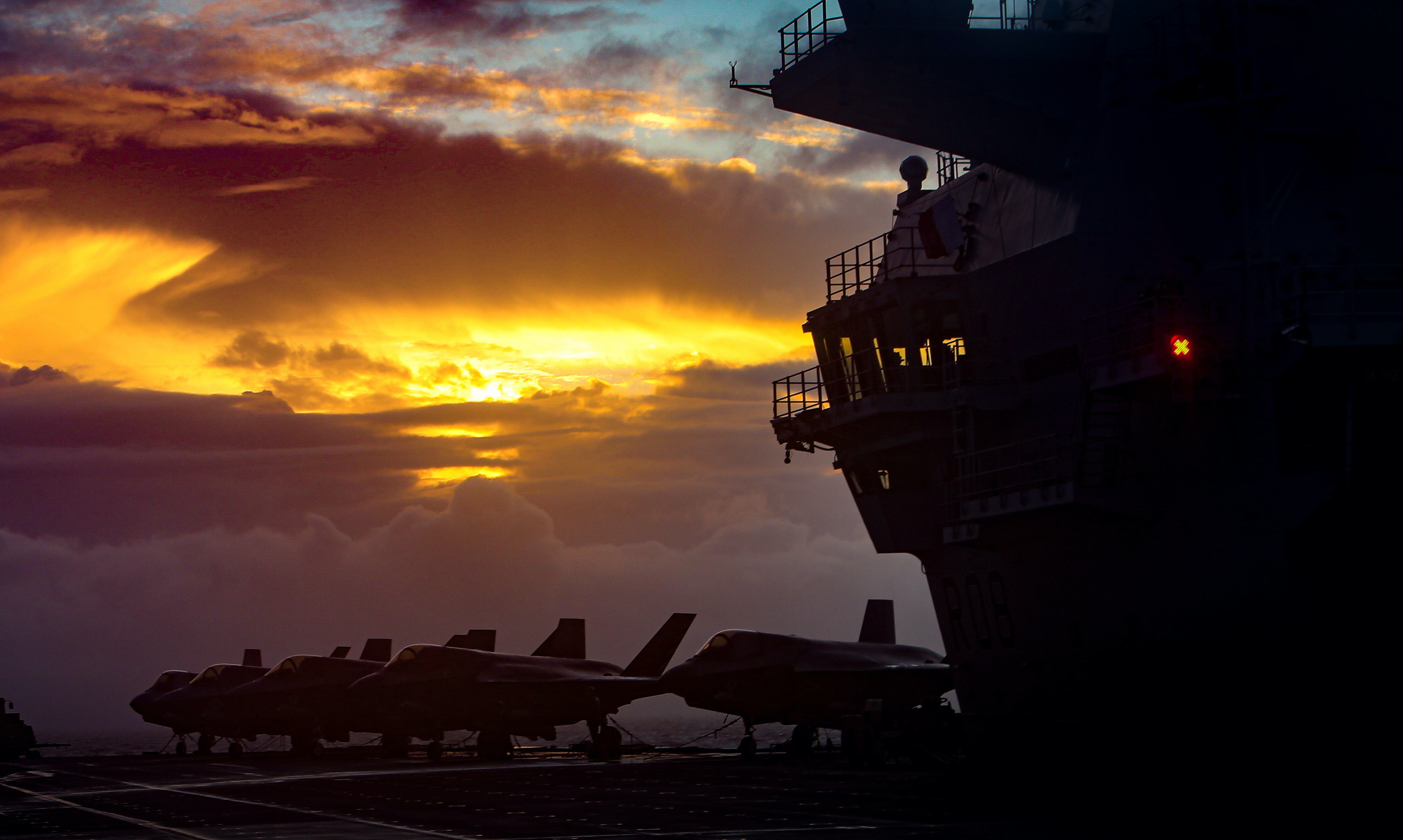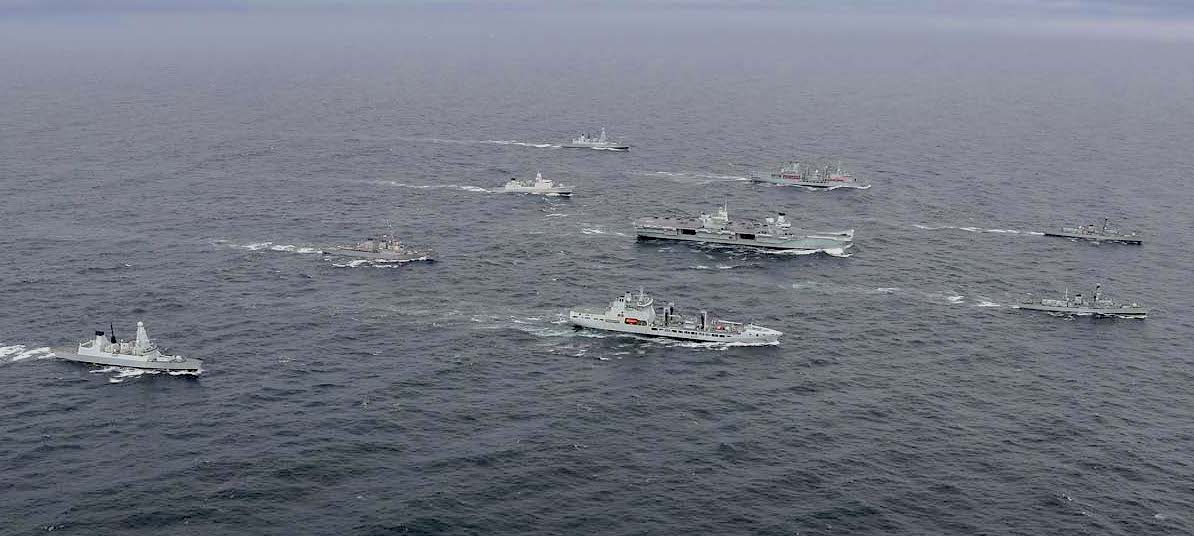
This post has been updated to include additional information from First Sea Lord Adm. Tony Radakin and US Navy acquisition chief James Geurts.
The U.S. Navy and U.K. Royal Navy are drawing closer together, going beyond making the fleets interoperable or integrated and instead aiming for interchangeability in carrier operations, undersea warfare and more, Chief of Naval Operations Adm. Mike Gilday announced today.
Gilday, speaking in a recorded video shown at the Atlantic Future Forum 2020 event held aboard HMS Queen Elizabeth (R08), said that “after months of hard work on both sides of the Atlantic, I am proud to announce that the First Sea Lord and I will sign a future integrated warfighting statement of intent that will set a cooperative vision for interchangeability. We will synchronize pioneering capabilities, strengthen operating concepts and focus our collective efforts to deliver combined seapower together. By organizing our cooperation on carrier strike, underwater superiority, Navy/Marine integration and doubling down on future warfighting like unmanned and artificial intelligence, we will remain at the leading edge of great power competition.”
This announcement comes after Queen Elizabeth wrapped up operations in a NATO exercise off Scotland that included launching F-35B Joint Strike Fighter jets both from a British squadron and a U.S. Marine Corps squadron. The strike group also included USS The Sullivans (DDG-68) and Dutch frigate HNLMS Evertsen (F805).
Queen Elizabeth Commanding Officer Capt. Angus Essenhigh said during the AFF 20 kickoff that his ship had been “equipped with the most fifth-generation strike power ever deployed at sea: an incredibly potent blend of U.K. and U.S. Marine Corps F-35B jets working together in a way that’s taken the very concept of interoperability to a whole new level, where we now aspire to not only achieve interoperability but interchangeability, in which the U.K. and U.S. jets fly in mixed formations against common target sets.”
Gilday added in his remarks that the U.S. and U.K. navies “have a long tradition of sailing together, from the Atlantic to the Indo-Pacific. No doubt our storied past has strengthened our friendship today and will do so far far into the future.”
First Sea Lord Adm. Tony Radakin said during his opening remarks that they are “two different nations but one common goal: that of making not only the Atlantic but also the world more secure, more prosperous and more equitable for everyone.”
During a later panel alongside Navy acquisition chief James Geurts, Radakin said the agreement with Gilday is “really a reflection that, for many of us all through our careers, we have had a drive for interoperability, about being able to work with foreign allies, and sometimes that’s relatively basic: it’s about being able to talk to each other, being able to understand each other, being able to work together, our systems being able to complement each other. But increasingly it feels to us that that bar has to be raised, and to recognize that going forward there will be a lot more times where we are actually talking about interchangeability. And that’s already happening.”
He cited not only the F-35B operations but also undersea warfare operations in the North Atlantic between the U.K., U.S. and other regional partners, using submarines, surface ships and aircraft to monitor for Russian submarine activity.

During that discussion, Geurts announced that, in addition to the dozen “Tech Bridges” he’s stood up throughout the U.S. to facilitate conversations between warfighters, industry – with companies big and small, in the defense sphere and in other markets – academia and more, another Tech Bridge would be established in London to further this interchangeability concept.
“We’re going to establish our first-ever overseas Tech Bridge there in London. It will be a place for two-way sharing of ideas. And it’s not just government to government, it’s with industry, it’s with academia, quite frankly it’s with everyday citizens who may have an idea,” Geurts said.
“And the power of these Tech Bridges is they’re not on bases, they’re not behind barbed wire, they’re not just only a requirements-pull. It’s a way that we can get idea-push and accelerate that.”
He added that the U.S. and U.K. had the right vision for where they wanted to go in the future as it relates to new technologies to win in great power competition, but that they needed to work on buying and fielding tech quickly and at scale, which is something the Tech Bridge could aid in.
Radakin added that the U.K. Royal military today wasn’t as innovation-friendly as it had been in past eras but that it was trying to change that and create a culture of innovation and experimentation. He said they’re making progress working with industry to test prototypes, but that it’s still a struggle to get successful prototypes through the bureaucracy and into the acquisition system as a program of record, which is something he hopes the partnership with the U.S. could help with.
Still, he made clear that the interchangeability drive with the U.S. wasn’t just about the U.S. helping the U.K. – it’s a two-way street, he said.
“I think we have a bunch of things that speak to what’s going on: the significance of the United States of America investing an air wing onto another nation’s aircraft carrier is a remarkable achievement, and it speaks to a remarkable relationship in terms of trust and confidence and the ability to work together,” he said.
“We have a program whereby we’re investing in an extra-large underwater drone, that’s one of the largest underwater drones in the world, it’s being built in Plymouth. We’re working together so that we both benefit from that kind of technology. We have another U.K. program which is called MAPLE [Maritime Autonomous Platform Exploitation], which is the mechanism whereby you can control your drones and you can speak to your drones and they can speak to each other, which again is a fundamental of effective warfighting. And where we think that that technology and some of the success we’ve had might be of interest to the U.S., these are the things we’re sharing.”
Gilday and Radakin, along with French counterpart Adm. Christophe Prazuck, who served as Chief of Naval Staff of the French Navy until a September change of command, conducted a virtual trilateral maritime discussion on June 12 to discuss advancing warfighting interoperability and deepening cooperation between the three NATO allies.
“Together, with my British and French counterparts, we reaffirm our commitment to our global partnership and responsibility to a free and open maritime commons,” Gilday said in a news release following the discussion.
“Through continued dialogue and shared lessons learned, we are strengthening our forces’ interoperability and collective ability in upholding a rules-based international order at sea.”
This trilateral cooperation has also included a wargaming series. Last year’s inaugural event was hosted by the U.S. Navy and focused on anti-submarine warfare, USNI News previously reported. This year’s wargaming event, also conducted virtually, was led by the U.K. and focused on multi-carrier operations. France will host the wargame in 2021.





